MACON STREET VS. CHARLIE CHAPLIN (1913)
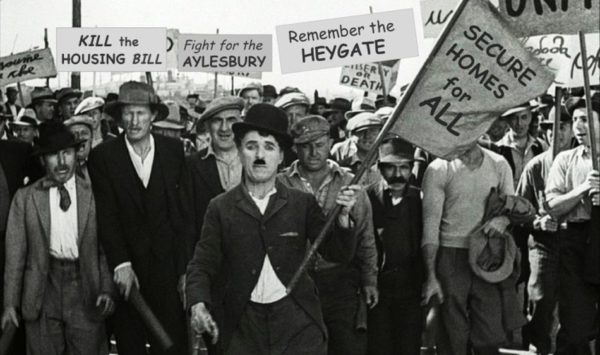
******************************************************************************************************************************** Brownstone Detectives investigates the history of our clients’ homes. The story you are about to read was composed from research conducted in the course of one of those investigations. Do you know the history of YOUR house? ******************************************************************************************************************************** In 1913, “Charlie Chaplin” was set to hit Bed-Stuy – in a big way. Let me explain. The residents of Stuyvesant Heights – 100 years ago – were concerned about any proposed construction developments that might encroach upon the way of life to which they’d grown accustomed. New people were moving into the neighborhood, new businesses opening up, and the residents felt they were losing control of what was going on around them. Specifically, they were justifiably troubled with the type of buildings the local developers might be planning to construct in their midst. In 1913, it was the movie houses. NOT IN MY BACKYARD! The construction of a “moving picture show” on Macon Street (near Lewis Avenue), was so unpopular, in fact, that its residents would take drastic measures against the proposal to build one “directly opposite the Public Library in Lewis Avenue.” The new theater was to go up on the northwest corner of Macon Street and Lewis Avenue, where a 3-story wooden structure (with a 2-story addition at back) had existed since the last century. Surrounded by their “fine residences,” the residents expected the lot to attract an establishment that would be more in keeping with the status of the neighborhood. When residents discovered, though, that the owners […]
DRUNKS, URCHINS & FAST YOUNG MEN (1853)
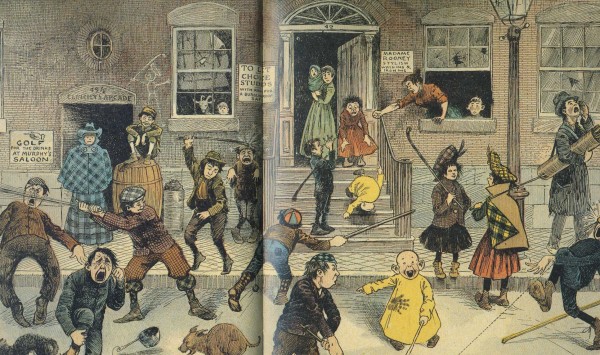
******************************************************************************************************************************** Brownstone Detectives investigates the history of our clients’ homes. The story you are about to read was composed from research conducted in the course of one of those investigations. Do you know the history of YOUR house? ******************************************************************************************************************************** “Ragged little boys, with dirty faces, trousers out behind, who sleep in coal boxes on door mats and stoops, pitching pennies and searching in the gutter.” So began a letter to the Brooklyn Daily Eagle in 1853 from an anonymous reader known simply as “Atlas.” Atlas was wondering why theater in New York did not spring from everyday life – as he saw it. And what he described painted a picture of Brooklyn life that has long drifted away, although it is still with us in other formats. Here are the characters that Atlas saw in Brooklyn in 1853: “Older boys with lips pouring out terrible oaths, disgusting obscenity, the fumes of penny cigars and cheap rum. “Old men tottering from dilapidated vermin-infected tenements, to smoke and drink at some low-roguery, whose greasy, fancy-colored decanters are so enchanting to every Godforsaken drunkard. “Slouchy, course-looking servant girls emptying slops into the gutter, and with pail in hand, stopping to exchange ribaldry with an idle neighbor, and retail scandal about the infidelities of their mistresses. “Faded women, with low-necked dresses, who indulge in very liberal views about virtue and chastity, with painted cheeks and brassy looking countenances, searching for verdant countrymen, to indulge with them in beastly licentiousness. “Lazy wives, with frouzy uncombed […]
RUTHLESS RHYMES FOR MARTIAL MILITANTS (1914)
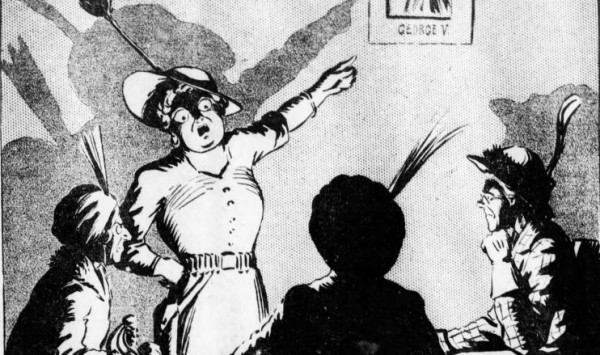
******************************************************************************************************************************** Brownstone Detectives investigates the history of our clients’ homes. The story you are about to read was composed from research conducted in the course of one of those investigations. ******************************************************************************************************************************** To celebrate Women’s Suffrage, we harken back to a day when women suffragettes were pilloried in Brooklyn – publicly – and could not even vote! RUTH-LESS Nothing is easy in life. Women have had it extra hard. Some would argue that it is worse now than it was even back before women had “rights.” But what was it like back then? How high was that glass ceiling? How did Brooklyn treat its women suffering for their rights and the rights of other women? It is not likely that there was much difference between Manhattan and Brooklyn – or Brooklyn and Cleveland, for that matter. It was merely the details that were different – the players, the events, the locations. Brooklyn, though, seemed to have started its anti-suffragette campaign in earnest by having a lark of it in 1914, joking about the movement while sticking the knife in, so to speak, and twisting it with a sort of sinister glee. RHYMES The Brooklyn Daily Eagle, that year, published a series of cartoons by one of its more able cartoonists, Nelson Harding, called “Ruthless Rhymes for Martial Militants.” The cartoons not only showed women in a demeaning light, but they poked fun about their fight for their rights – as well as their chances for success. The cartoons, though clever, were […]
POLICE COMMISH LIKES THE LADIES (1915)
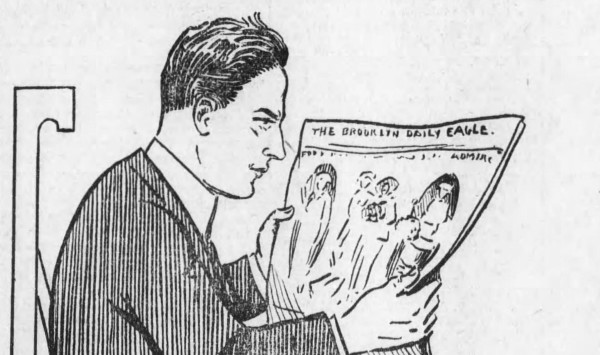
When Brooklyn’s Deputy Police Commissioner Godley laid eyes on the beauties in the newspaper spread, he couldn’t contain himself. He wrote to the Brooklyn Daily Eagle to offer them police protection. “It is unusual for us to offer police assistance, since we ordinarily have enough work to do for all of the policemen we have and a good many more, but I am sure that you will need it after publishing photographs of but four of the beautiful young women of Brooklyn.” So, he made the following offer: “We shall be glad to furnish whatever protection may be necessary even to the extent of calling out the entire force.” The Eagle, in response, offered a poem, the last two stanzas of which we offer here – the first of which comes in the voice of the Deputy Commissioner Godley himself, followed by an answer from the newspaper: “If harm seems to threaten those charming young misses; We’ll keep them in Brooklyn, where nothing but bliss is. But why publish four, when you know that is hardly Fair to other Brooklyn girls? – Yours truly, Godley.” “Dear Godley” – (The Eagle makes haste to respond) “We note your advice, so please don’t despond; Send us lots of photos of beauties – don’t stint ’em; Be assured that The Eagle will be glad to print ’em.” Five years later women would begin to be taken more seriously. No longer just beauties to be gawked at in newspaper spreads, in 1920 they would […]
BROOKLYN’S “GREAT WHITE HURRICANE” (1888)
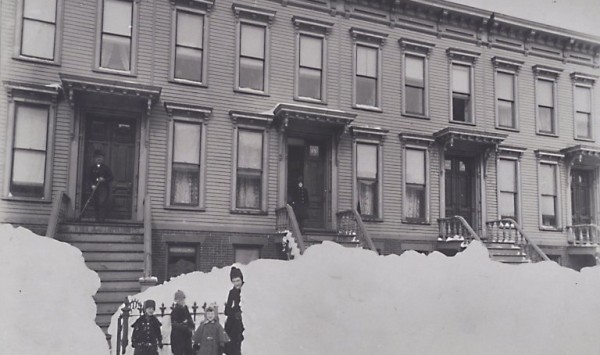
“Brooklyn awoke this morning to find itself in the hands of the blizzard.” So read the morning edition of the Brooklyn Daily Eagle almost 130 years ago on Monday, 12 March 1888, about the record snowstorm that, over a day-and-a-half period, dropped up to three feet of snow on the city, produced sustained winds of 40 miles per hours, and created snowdrifts in some places in excess of 50 feet! Nearly all transportation was shut down completely and many Brooklynites were confined to their homes for up to a week. While the city slept the rain that had rendered last evening slightly unpleasant had turned to snow, the wind had increased to a tempest and all life was driven from the streets. Street cars were unable to proceed. The horses were detached and taken to the nearest place of shelter. The inmates of the cars saw the huge drifts of snow pile up above the window ledges, heard the shrieks of the wires above their heads and did not leave the cars unless an open house was very near at hand. It was about 1 o’clock when the storm became furious and it raged for ten hours with undiminished violence. Those who ventured out during the morning were treated to a view of the city unparalleled in its history. During the entire morning there was little concerted effort, except along the principle business part of Fulton Street, to open traffic or carry on any business. Half the city felt that […]
“PLAIN” GIRLS SHOULD GO TO COLLEGE (1911)
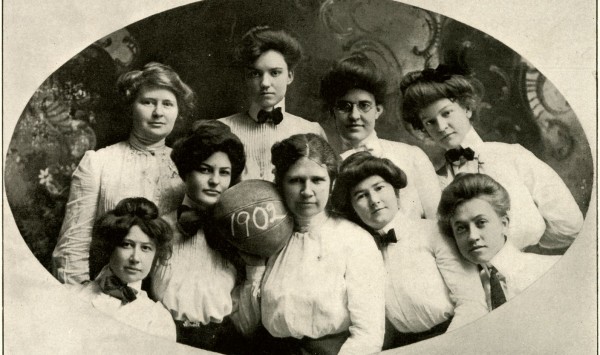
******************************************************************************************************************************** Brownstone Detectives investigates the history of our clients’ homes. The story you are about to read was composed from research conducted in the course of one of those investigations. Do you know the history of YOUR house? ******************************************************************************************************************************** It’s tough being plain. But if you go to college you increase your chances of getting that “MRS” degree. So said Brooklynite Imogene Kelly who, while in her senior year at Wellesley College in Massachusetts, was editor-in-chief of the school’s newspaper, Wellesley College News. The top scribe’s job gave the sensible young lady ample opportunity to place her thoughts before her adoring public. After her piece about the necessity of homely girls attending college to increase their chances of marital bliss, though, Kelly hadn’t much of an audience at all. WHY GIRLS GO TO COLLEGE In an article in the Brooklyn Daily Eagle, Kelly was showcased for her viewed of the necessity of a college education. “The unattractive girl, in order to equalize her chances for a husband with the less plain girl, must do so by getting an education,” Kelly reported. “The girl who is attractive and good looking need not secure a college training in order to fulfill her marriage destiny.” Kelly’s story, though, earned her an audience far beyond the campus of Wellesley, as it was picked up by a number of news services and printed in many places around the country. “The girls at Wellesley, as a rule, are not beautiful, and for that reason these girls […]
92 ROUNDS IN IRISH RED HOOK (1864)
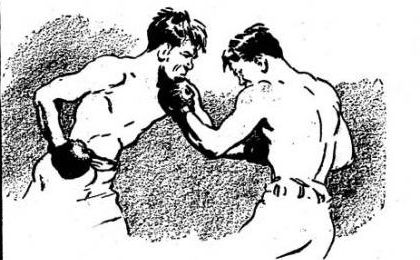
******************************************************************************************************************************** Brownstone Detectives investigates the history of our clients’ homes. The story you are about to read was composed from research conducted in the course of one of those investigations. Do you know the history of YOUR house? ******************************************************************************************************************************** It was an amazing feat even for the times. Although fights were often arranged for the amusement of their onlookers or the profits of the inevitable bettors back then, unauthorized prize fights were, even in 1864, against the law. It was in that year that just such an illegal “Feather Weight” contest was arranged, “in the rosin yard at the foot of Van Brunt street at 7 o’clock” the morning of 4 December. IRISH BARE-KNUCKLE BOXING The Irish, it was maintained, were known for their fighting spirit, and Red Hook, having no dearth of wiry Irish lads looking to swing a punch or two at any adversarial comers, this particular match did not appear to be an uncommon occurrence. There was no main stake in the result of the fight, noted the Brooklyn Daily Eagle, but “small bets were plentiful, and over $1,000 in greenbacks were said to have changed hands on the issue.” The Brooklyn Daily Eagle called the affair “disgraceful,” but then went on to describe the “prize fight” and its participants in the most glowing and respectful tones, noting that “the lovers of the manly art rejoiced.” THE CONTESTANTS One of the boys was Paddy McGrath, “who belongs at the corner of Van Brunt and Wolcott street when […]